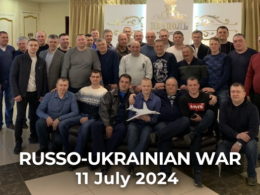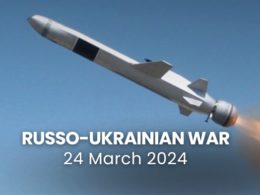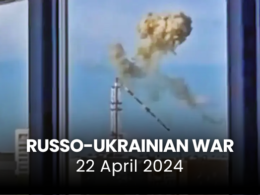Morning report day 83 – May 17
The report is based on media reports, expert analyses, and official information posted online.
Norway is today celebrating its Constitution Day and in essence, Norwegian independence and sovereignty. Today, more than ever, my thoughts go to Ukraine and its fight for something most of us take for granted: our independence and sovereignty. I for one would like to dedicate the day to the brave Ukrainian men and women fighting for not only their right to exist as a nation, but also their fight for our shared values and principles and, not least, European security and stability.
Situation
According to information from the General Staff as of 06.00 17.05.2022, supplemented by its [18:00 assessment].
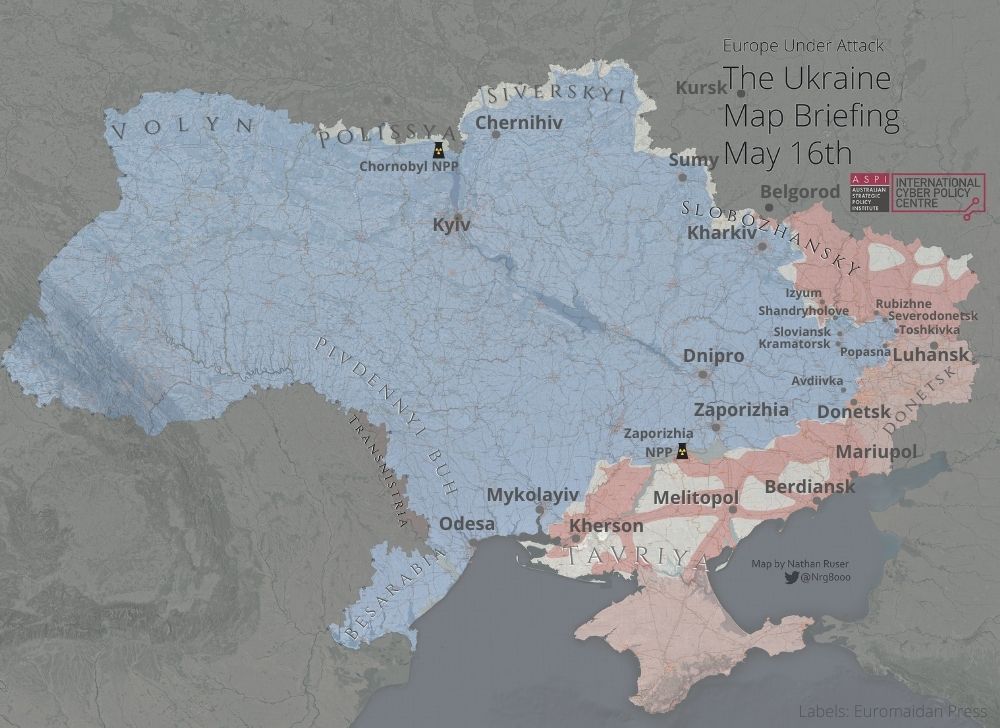
[Russian forces focused their main efforts on the Donetsk direction. In the Slobozhanskyi direction, it is trying to deter the offensive of the Defence Forces north of the city of Kharkiv and prevent them from reaching the State Border of Ukraine. Prepares for offensive operations by units concentrated in the area of the city of Izium.]
Russian aircraft destroyed civilian and military infrastructure in the Eastern Operational Zone and industrial facilities deep in Ukraine.
In the Volyn and Polissia directions, the situation has not changed significantly, the threat of missiles and airstrikes from the territory of the Republic of Belarus on the infrastructure of Ukraine continues.
In the Siverskyi direction, Russian forces continue to provide enhanced protection of the Ukrainian-Russian border. In the area of the settlement of Bilokopytove, Sumy Oblast, Russian forces fired mortars at units of the State Border Guard Service of Ukraine.
In the Slobozhanskyi direction, Russian forces are concentrating their main efforts on deterring the offensive of units of the Defence Forces.
- [The enemy reinforces the grouping of troops with special forces and air defence units.]
- In the Kharkiv direction, Russian forces’ main efforts are focused on maintaining their positions and preventing the advance of our troops.
- [The enemy tried to fight in the direction of the village of Ternov but was unsuccessful.]
- [In the Sloviansk direction, Russian forces, with the help of units of the 20th Guards Combined Arms Army, are replenishing and replenishing losses, trying to resume the offensive.]
- [The defence forces fired on enemy depots stationed in the town of Izium, destroying a significant stockpile of ammunition.]
https://twitter.com/EuromaidanPress/status/1526396588012077058
In the Donetsk direction, Russian forces continue to fire mortars, artillery, rocket-propelled grenade launchers and use aircraft.
- In the Lyman direction, Russian forces conducted offensive operations in the area of the settlement of Drobysheve. Strengthens troop groups. [Russian forces conducted offensive operations in the area of the village of Shandrygolove but had no success.]
- In the Sievierodonetsk direction, near the settlement of Syrotyne, Russian forces suffered losses during the fighting and withdrew. [Russian occupiers fought in the area of the settlement of Borivske and suffered casualties.]
- In the Bakhmut direction, Russian forces fought in the direction of the settlement of Vyskryva but had no success.
- In the Avdiivka direction, Russian occupiers fought in the direction of the settlement of Kamyanka, and also had no success. [Russian forces acted in the direction of the settlement of Sukha Balka. It fired on individual positions of the Defense Forces with cluster munitions.]
- [In the Bakhmut direction, Russian forces are fighting in the areas of Toshkivka and Pylypchatyne. In the area of Hirske, the Russian occupiers suffered losses and withdrew.]
- In the Kurakhove direction, the enemy launched an offensive in the direction of the settlement of Vuhledar but had no success. [Russian forces attacked in the area of Mariinka and Novomykhailivka but had no success.]
- [In Mariupol, Russian forces focused their efforts on blocking and defeating our units near the Azovstal plant. Continues massive artillery and airstrikes.]
- Russian forces did not conduct active hostilities in the Novopavlovsk and Zaporizhzhia directions. It carried out fire damage to civilian infrastructure in the areas of the settlements of Kamyanske, Orikhiv, Novosilka and Huliaipole.
- Eleven enemy attacks were repulsed in Donetsk and Luhansk over the past 24 hours, five tanks, one Tor anti-aircraft missile system, six artillery systems, twelve units of armoured combat vehicles and one enemy vehicle were destroyed.
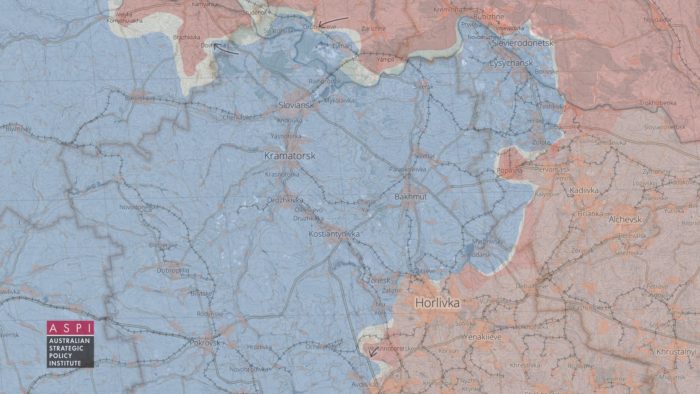
In the Pivdennyi Buh direction, Russian forces units did not conduct active hostilities, they fired at our units with artillery and mortars in the areas of the settlements of Lymany, Tavriyske, Trudoliubivka, and Osokorivka. [Yesterday, Russian forces shelled civilian infrastructure with artillery and mortars in the areas of the settlements of Oleksandrivka, Shevchenkove and Novovorontsovka.]
- In the Besarabian direction, because of a missile strike from Russian strategic aircraft, in the Bilhorod-Dnistrovskyi district of the Odesa oblast, objects of civil infrastructure were affected, and private buildings were destroyed.
- [The Defense Forces of Ukraine fired on the enemy’s field ammunition depot near the village of Davydiv Brid.]
- [The situation in the Transnistrian region of the Republic of Moldova remained without significant changes. Personnel of units of the operational group of Russian troops continue to be on high alert. Provocations by the Russian side in the region are not ruled out.]
[Ships of the Black Sea Fleet of the Russian Federation in the Black and Azov Seas continue to perform tasks to isolate the area of hostilities, surveillance and fire support in the coastal direction.]
- In the waters of the Black Sea, near the island of Snake, noted the conduct of hoisting and rescue operations at the site of the destruction of the Russian landing craft.
On the previous day, the air defence units of the Land Forces and the Air Force hit five air targets: a Su-25 aircraft, three operational-tactical UAVs and a cruise missile.
The strike aircraft of the [Ukrainian] Air Force in certain directions continued to fire at the enemy from the air and to support the fighting of units of Ukrainian troops.]”
Defeat near Bilohorivka: Enemy lost almost 1,000 soldiers and 100 vehicles, the Ukrinform reports.
“The disgraceful operation that they [the invaders] conducted in Bilohorivka will go down in the history of this war between Russia and Ukraine as their defeat in Luhansk Oblast. The Ukrainian Armed Forces defeated almost 100 units of equipment there. Two battalions were killed there, which is almost a thousand soldiers. Also, several pontoons were destroyed. All of their attempts to cross [the river] and create a bridgehead in Bilohorivka [failed], they were all defeated,” Serhii Haidai, head of the Luhansk Regional Military Administration, said in a video address published on Telegram.
Russian troops pushed to within 3-4 km of the Russian border near Kharkiv – US official, the Reuters reports. “Ukrainian forces have pushed back Russian troops near the country’s second-largest city of Kharkiv to within 3 to 4 kilometres (1.9-2.5 miles) of the Russian border, a senior US defence official said on Monday.”
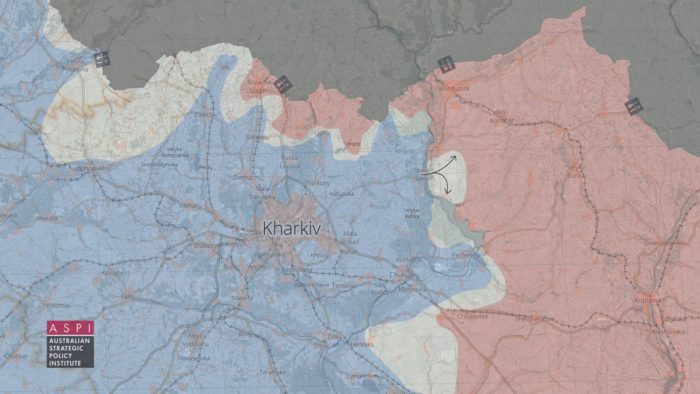
Russians are fortifying positions in Kherson and Mykolaiv oblasts, the Ukrinform reports. That’s according to an update delivered by Operational Command South as of the morning of May 16.
According to British Defence Intelligence, (last 24 hours):
- In Chernihiv Oblast north of Kyiv, approximately 3,500 buildings are estimated to have been destroyed or damaged during Russia’s abandoned advance toward the Ukrainian capital. 80% of the damage has been caused to residential buildings.
- The scale of this damage indicates Russia’s preparedness to use artillery against inhabited areas, with minimal regard to discrimination or proportionality. Russia has likely resorted to an increasing reliance on indiscriminate artillery bombardment due to a limited target acquisition capability, and an unwillingness to risk flying combat aircraft routinely beyond its own frontlines.
- In the coming weeks, Russia is likely to continue to rely heavily on massed artillery strikes as it attempts to regain momentum in its advance in the Donbas.
As of Tuesday 17 May, the approximate losses of weapons and military equipment of the Russian Armed Forces from the beginning of the war to the present day:
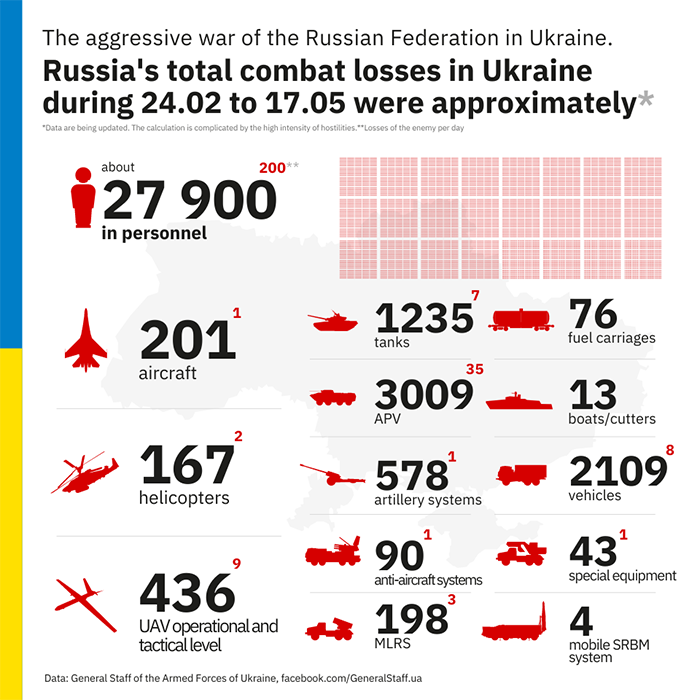
Russian enemy suffered the greatest losses (of the last day) in the Lyman and Zaporizhzhia directions.
By mid-March, about a hundred Russian tankers had surrendered, the Defence Intelligence of Ukraine (DIU) claims. Ukraine’s military intelligence had obtained documentary evidence of the loss of manpower and equipment of the 1st Tank Army of the Russian armed forces.
“The study and analysis of the obtained documents allowed to establish the list of units involved in the military invasion of Ukraine, military ranks and names of the occupiers who died during the hostilities, went missing, were captured or wounded.
As of March 15, 2022, the total loss of the 1st Tank army amounted to 409 people. Ukrainian soldiers eliminated 61 and wounded 209 occupiers. In the first two weeks of the war alone, 44 Russian tankers went missing and 96 occupiers of the army decided to save their lives and surrender. During the same period, the defenders of Ukraine destroyed and captured 308 units of military equipment from the army of the occupiers.”
Humanitarian
Russia says wounded Ukrainian soldiers will be evacuated from Azovstal to Russian-occupied territories of Donetsk and Luhansk oblasts, the Ukrainska Pravda reports. Interfax, citing the Russian Ministry of Defence, reports that “On 16 May, an agreement has been reached regarding the evacuation of the wounded [soldiers] as a result of negotiations with the Ukrainian military personnel blocked at the Azovstal steelworks in Mariupol.”
According to the Russian Ministry of Defence, a ceasefire at Azovstal has already begun and a humanitarian corridor has been opened to transport wounded Ukrainian soldiers to a hospital in Russian-occupied Novoazovsk, a town located in the Temporarily Occupied Territories of Donetsk and Luhansk oblasts.
The information has been confirmed by the Ukrainian Ministry of Defence. In a statement on Telegram, it states that “53 seriously wounded Ukrainian servicemen have already been evacuated from Azovstal to a hospital in Novoazovsk, where they will be provided with the necessary medical care. Also, 211 people have already been taken to the village of Olenivka via the humanitarian corridor. An exchange procedure will be carried out for the fastest return of Ukrainian heroes. As for the defenders who remain on the territory of Azovstal, all necessary rescue measures are being taken by our state. All tasks set by the command were fulfilled by the defenders of Mariupol in full. Unfortunately, today Ukraine cannot unblock Azovstal by military means.”
According to UNHCR 6,223,821 refugees have been registered as of May 15. The UN says that so far Poland has taken in 3,357,984 refugees, Romania 919,574, Russian Federation 838,434, Hungary 605,628, Republic of Moldova 463,348, Slovakia 421,662 and Belarus 27,308. Among those who fled Ukraine are also Ukrainian nationals with dual citizenship. An additional 105,000 people moved to the Russian Federation from Donetsk and Luhansk oblasts between 18 and 23 February.
The number of Ukrainians entering Ukraine since February 28 is 1,782,500 as of May 15. This figure reflects cross-border movements, which can be pendular, and does not necessarily indicate sustainable returns.
OHCHR recorded 7,564 civilian casualties in Ukraine as of May 15. 3,668 were killed (including 245 children) and 3,896 injured (including 358 children).
Environmental
Moscow says G7 attempts to isolate Russia make the global food crisis worse, the Reuters reports.
“Russia’s foreign ministry said on Monday that attempts by the West and the G7 group of nations in particular to isolate Moscow have worsened global food shortages.
“Attempts to divert Russia economically, financially and logistically from long-standing channels of international cooperation are only exacerbating economic and food crises,” the foreign ministry said in a statement on its website. “It should be noted that it was the unilateral actions of Western countries, primarily from the Group of Seven, that exacerbated the problem of breaking the logistics and financial chains of food supplies to world markets.
“Before the war, Ukraine and Russia combined accounted for about 29% of wheat production for the world market.”
Legal
 229 children were killed, and 423 children injured, the Office of the Prosecutor General of Ukraine reports as of May 17. 1,772 educational establishments are damaged as a result of shelling and bombings, 161 of them are destroyed fully. 11,846 crimes of aggression and war crimes and 5,644 crimes against national security were registered.
229 children were killed, and 423 children injured, the Office of the Prosecutor General of Ukraine reports as of May 17. 1,772 educational establishments are damaged as a result of shelling and bombings, 161 of them are destroyed fully. 11,846 crimes of aggression and war crimes and 5,644 crimes against national security were registered.
Support
Germany to deliver Panzerhaubitze 2000 howitzers, Gepard anti-aircraft tanks, bazookas to Ukraine, the Ukrinform reports. Germany will hand over seven Panzerhaubitze 2000 howitzers to Ukraine, and the supply of anti-aircraft tanks and other military equipment is being planned. German government spokesman Steffen Hebestreit said this at a briefing on Monday, according to an Ukrinform correspondent.
“Deliveries [of weapons and military equipment] continue. We’re talking about Panzerhaubitze 2000 howitzers, which Ukrainian soldiers are currently being trained to operate, the sending of Gepard tanks, and the supply of bazookas and other military equipment,” he said.
German Ministry of Defense spokesperson David Helmbold, in turn, said that an international project on howitzer training is underway, it is designed for 40 days, but the deadline may be revised.
West will not allow Russia a ‘diktat peace’ in Ukraine, says Germany’s Scholz, the Reuters reports, “Russia will not get away with trying to redraw Ukraine’s borders by creating facts on the ground and waiting out Kyiv and its allies, Olaf Scholz said, insisting that the West would not stand for a “diktat,” or dictated, peace forced on the country.
Ukraine’s President Voldomyr Zelenskyy said last week that Kyiv would not trade territory for peace with Russia, telling Italy’s RAI television that he had been asked by French President Emmanuel Macron to consider doing so (read more).
The French government has denied that any such suggestion had been made. On Monday, Scholz said that such stealth border changes would not be accepted by the West if Ukraine objected to them.
“There is only one way out of this for Russia and that is reaching an agreement with Ukraine,” he told RTL television. “And that doesn’t mean a diktat peace, taking a bit of territory and then saying ‘sign here’.”
New developments
- Putin sees no threat from NATO expansion, and warns against military build-up, the Reuters reports. “President Vladimir Putin said on Monday that there was no threat to Russia if Sweden and Finland joined NATO but cautioned that Moscow would respond if the US-led alliance bolstered military infrastructure in the new Nordic members. Putin […] has repeatedly cited the post-Soviet enlargement of the NATO alliance eastwards toward Russia’s borders as a reason for the conflict in Ukraine.
The Kremlin chief’s remarkably serene response to one of Russia’s most sensitive geopolitical worries – the post-Soviet enlargement of NATO – contrasted to some tougher language from his foreign ministry and senior allies.”
- The Kremlin explained why Ukraine is bad in NATO and Finland and Sweden are not, the Ukrainska Pravda reports citing Kremlin’s RIA Novosti. “We have no territorial disputes with either Finland or Sweden. While Ukraine could potentially become a member of NATO, Russia would then have a territorial dispute with a member state of the Alliance which poses enormous risks to the entire continent, Kremlin spokesman Dmytro Peskov said. This is a serious issue that is of concern to us. We will closely monitor the implications of Finland’s and Sweden’s accession to NATO in terms of our security, which must be ensured with absolute certainty. “
- Sweden to bid for NATO membership seeks to overcome Türkiye’s objections, the Reuters reports. “Sweden’s government has formally decided to apply for NATO membership, Prime Minister Magdalena Andersson said on Monday, setting it on the road toward ending military non-alignment that lasted throughout the Cold War. She said the application could be handed in on Monday, Tuesday or Wednesday and would be synchronised with Finland, which has also confirmed it would apply to join the military alliance”.
- Nordic neighbours vow to help Finland and Sweden in case of attack, the Reuters reports. “Norway, Denmark and Iceland in a joint statement on Monday said they stand ready to support NATO applicants Finland and Sweden in case the two Nordic nations were to come under attack”.
- The United States believes that Ukraine can “bypass” the MAP on the way to NATO, as Finland and Sweden, the European Truth reports. “According to US Chargé d’Affaires Christina Quinn, Ukraine has a chance to become a member of NATO without a member of the Membership Action Plan, such as Finland and Sweden, because it is not a mandatory part of the accession process. “As for the possibility of Finland’s accession without a MAP, the Membership Action Plan has never been a legal requirement for NATO membership, so Ukraine can also join the Alliance without a MAP. However, I would not call it a shortened procedure,” she said. She noted that the MAP is a mechanism that allows a Member State to meet compatibility requirements, and if a State already meets all the requirements, the Membership Action Plan becomes unnecessary.”
Assessment
On the War
The Institute for the Study of War has made the following assessment as of Monday 16 May:
Russian shelling causes explosion at ammonia nitrate warehouse in Kharkiv Oblast. Reported by Donetsk Oblast Military Administration Head.
"The explosion does not pose a threat to the local population."https://t.co/NNegH0DAHH pic.twitter.com/yFitti5xhw
— Euromaidan Press (@EuromaidanPress) May 16, 2022
 Russian military bloggers continued to post analysis that is skeptical of Russian efforts and increasingly in-line with Western assessments of Russian military failures in Ukraine. One such blogger, Igor Strelkov, claimed that the Russian offensive to take Donbas has ultimately failed and that “not a single large settlement “has been liberated. Strelkov even noted that the capture of Rubizhne is relatively insignificant because it happened before the new offensive in Donbas had begun. Strelkov stated that Russian forces are unlikely to liberate Donbas by the summer and that Ukrainian troops will hold their positions around Donetsk City. Strelkov notably claimed that Russian failures thus far have not surprised him because the intent of Russian command has been so evident throughout the operation that Ukrainian troops are aware of exactly how to best respond and warns that Russian troops are fighting to the point of exhaustion under “rules proposed by the enemy.” The continued disenchantment of pro-Russian milbloggers with the Russian war effort may fuel dissatisfaction in Russia itself, especially if Moscow continues to press recruitment and conscription efforts that send poorly trained cannon-fodder to the front lines.
Russian military bloggers continued to post analysis that is skeptical of Russian efforts and increasingly in-line with Western assessments of Russian military failures in Ukraine. One such blogger, Igor Strelkov, claimed that the Russian offensive to take Donbas has ultimately failed and that “not a single large settlement “has been liberated. Strelkov even noted that the capture of Rubizhne is relatively insignificant because it happened before the new offensive in Donbas had begun. Strelkov stated that Russian forces are unlikely to liberate Donbas by the summer and that Ukrainian troops will hold their positions around Donetsk City. Strelkov notably claimed that Russian failures thus far have not surprised him because the intent of Russian command has been so evident throughout the operation that Ukrainian troops are aware of exactly how to best respond and warns that Russian troops are fighting to the point of exhaustion under “rules proposed by the enemy.” The continued disenchantment of pro-Russian milbloggers with the Russian war effort may fuel dissatisfaction in Russia itself, especially if Moscow continues to press recruitment and conscription efforts that send poorly trained cannon-fodder to the front lines.
Over 260 Mariupol defenders evacuated from the Azovstal Steel Plant to Russian occupied settlements in Donetsk Oblast on May 16. Ukrainian and Russian authorities negotiated evacuation for wounded Ukrainian servicemen via humanitarian corridors. Ukrainian officials previously called for the evacuation of 60 medics and critically wounded servicemen on May 13. The Kremlin may extend humanitarian corridors for remaining Ukrainian defenders in an effort to fully control Mariupol.
Frictions between Russian occupation administrations and pro-Russian collaborators is growing in occupied areas of Ukraine. The Zaporizhzhia Oblast Military Administration reported that Russian forces are having serious conflicts with collaborators due to interpersonal power conflicts. A well-known collaborator in Zaporizhzhia accused the Russian-installed governor of the area of stealing his 10,000 ruble compensation. Advisor to the Mayor of Mariupol Petro Andryshchenko additionally claimed that relatives of those mobilized into the forces of the Donetsk People’s Republic (DNR) are holding a mass protest against mobilization in Donetsk City. While ISW cannot independently verify these claims, such discontent amongst occupation elements suggests a general lack of planning by Russian authorities in occupied areas, now compounded by increasingly evident Russian losses.
Key Takeaways
- Russian and Ukrainian authorities negotiated the evacuation of 264 wounded Ukrainian servicemen from the Azovstal Steel Plant on May 16.
Evacuation of Ukrainian soldiers is underway from Azovstal in occupied Mariupol
- Ukrainian forces reached the Russian border north of Kharkiv City.
- Russian forces continued unsuccessful ground operations in Donetsk and Luhansk Oblasts and did not make any confirmed advances on May 16.
- Russian forces continued to fortify their positions in Zaporizhzhia Oblast.“
On state TV, a retired Russian colonel gives frank assessment of war, isolation, The Washington Post reports. “A retired Russian colonel told state media on Monday that the invasion of Ukraine is not going the way Russia is portraying it, and that the global isolation facing the country is more daunting than Russian leaders are letting on.
“After all, the main deficiency of our military-political position is that, in a way, we are in full geopolitical isolation, and that, however much we would hate to admit this, virtually the entire world is against us,” Mikhail Khodaryonok said, according to a video translated by the BBC’s Francis Scarr. “And it’s that situation that we need to get out of.”
When asked about the current state of the war, Khodaryonok, who has given frank assessments of the war on Russian airwaves in recent days, urged viewers to be cautious about any information put out by Russia on how Ukrainian forces “are allegedly on the verge of some kind of crisis in morale and so on.” “All of that, to put it mildly, is false,” he said.
Khodaryonok referenced how the US Congress is poised to approve nearly $40 billion in additional military and humanitarian aid for Ukraine, and what that could look like for Russia if Ukraine potentially employs a force of “a million-armed Ukrainian soldiers.”
“We need to take that into account in our own operational and strategic calculations, that the situation in this regard for us will frankly get worse,” he said on state TV.
As state media host Olga Skabeyeva pushed back on Khodaryonok and said that the Ukrainian forces are “not such a great contingent,” the retired colonel replied that the will of Ukraine mattered more than whether they are “professional” soldiers. “The thing is that the level of any army’s professionalism is determined not by the number of those recruited for professional service but by the level of the personnel’s training, and its morale and readiness to shed blood for the homeland,” he said.
Then, as Skabeyeva attempted to equate Ukrainian forces’ “desire to die” to professionalism, Khodaryonok shot down the state media host’s assertion, saying “it’s a component of an army’s high combat readiness.” “The main thing in our [military] business, it’s always to maintain a sense of military-political realism,” he said. “If you go beyond it, then sooner or later the reality of history will hit you so hard that you’ll regret it.”
Thoughts on Russian losses. Michael Kofman, Director, Russia Studies at CNA. Senior Adjunct Fellow, CNAS, published his assessment of the number of Russians Killed in Action (KIA) since 24 February on Twitter. It is building on the report from DIU claiming that about a hundred Russian tankers had surrendered by mid-March and elaborating on the losses of the 1st Tank Army in the same period, as well as the British Intelligence report from 15 May assessing that Russia has likely suffered losses of one-third of the ground combat force it committed in February.
“A thorny subject I’ve stayed away from because it’s difficult to tackle and the information gaps are vast. Numbers get thrown about with broad ranges, and it is hard to say what to make of these estimates, or guestimates. The numbers of most interest are killed in action (KIA) and total casualties. How you get there is going to be closely tied to your assumptions about KIA, and the ratio of wounded in action (WIA) to KIA.
Also, some militaries report more wounded, and even some branches within the same military may report this a bit differently. Russians don’t necessarily report wounded the same way we might. But this is getting into the weeds.
There are other types of losses, POW, MIA, and a soldier could be taken off the line due to illness or non-combat related injuries, etc. These could further increase the gap between total casualties which degrade unit effectiveness and just KIA.
Where I’m going with this is that KIA are likely to represent a fairly small share of total casualties. Some wounded may still fight, but units can be rendered combat ineffective by virtue of the number killed, wounded, and other casualty types. A fair ratio, assuming weak availability of field hospitals and poor combat medicine might be 3.5x WIA for every KIA. This is simplistic, ignores other casualty types and I’m just scratching the surface. For example, 10,000 KIA would result in 35,000 WIA, and a total of 45,000 casualties.
As one potential data point, 1st Guards Tank Army figures published by Ukraine through March 15th could be genuine. They show 61 KIA, 209 WIA, 44 MIA, and 96 POW. This is during a high period of RU losses in the war. That’s 3.4 WIA to KIA, and 5.7 overall.
So how can we figure out what might be plausible regarding Russian KIA and total casualties? First, it’s hard to go off of oblique official estimates and selective intel releases. Things won’t add up. No good way to know what is being counted or how. Also, it can change over time. For example, it appears at some point US official BTG counts started to include the DNR/LNR units whereas before it seemed they did not. So, the initial BTG counts of 125-130 may not have included the ‘separatist’ corps or Rosgvardia.
Also, these estimates are done in ranges and with confidence levels. Governments typically release these figures without explaining the estimate range, or their confidence level in those figures. So, you might be hearing a conservative or a high estimate.
Combatants in war will often overstate opponent losses and understate their own, or not release those figures at all. This is to be expected. The numbers are intertwined with information operations, considerations of own troop morale, external support, etc.
The first problem is figuring out Russia’s initial force. As we’ve come to learn the average BTG size was probably not 800, or 750, but probably closer to 600. Not all units deployed as BTGs, but the main manoeuvre force was possibly 80-90,000. Auxiliaries such as ‘separatist’ army corps, and Rosgvardia might be another 20-25,000. And an unknown amount of non-BTG dedicated support units. These are difficult to estimate, but they would not dramatically inflate the force involved.
Making a third of BTG formations combat ineffective (50% casualties) could require just 3,300 KIA. Indeed, 10,000 KIA could easily add up to 45,000 total casualties or more. 15,000 KIA would take it towards 75,000. I’m using just 3.5 as a multiplier here (imagine applying x5.7). The problem with higher range KIA counts is that you quickly develop input/output problems. There are more casualties than could feasibly be involved in the fight. That is, certain numbers become implausible given the size of forces involved.
What about Russian reinforcements? Well, assuming 10-15 BTGs additional from the rest of the force, and other sources like mercenaries, you might be looking at another 10-12,000 troops in the war during the second phase. It does not dramatically alter the picture. Alternatively, one could assume 150,000 forces massed on Ukrainian borders on Feb 23rd (not 190k total operational related force). Here I’m doing what I advised against, using opaque official figures, but I know it is tempting. 1/3 of that figure, as total casualties, could come from ~12,000 KIA.
This is all circling around a target. Given the gaps, my own confidence is quite low, but I think some of the figures out there don’t reconcile well. Based on what I suspect, but ultimately don’t know, I think 7,000 is low, 15,000 is high, and 10-12,000 KIA might be the middle. To me this is a high casualty figure both relative to the potential size of the force involved, and Russian casualties in other wars. However, others might have a different take on this.”
ME: The assessment above, as Michael Kofman underlines, is based on several assumptions. This includes the total number of troops deployed, the number of soldiers directly engaged in the fight (versus auxiliary units left behind) and the validity of statistics from past wars.
His assessment, does, however, not discuss some of the reported variables that might potentially, make this war an aberration compared to past wars. We have seen reports and intelligence indicating both a faulty strategy and extremely bad Russian leadership.
The technical status of the material employed has been questioned. We know Russia has suffered huge losses of tanks and armoured personnel carriers. The weapons employed against them have proven extremely efficient, leaving fewer wounded in action (WIA) than in a firefight between regular troops.
More importantly, we have seen multiple reports undermining the professionality of the Russian Armed Forces. Soldiers that have allegedly been promised to serve as auxiliary forces behind the frontline have ended up fighting in the frontline and hot spots. We have seen claims of the use of conscripts, and soldiers deployed into the theatre with minimum training. Additionally, Ukrainians on temporarily occupied territories have reportedly been forcibly mobilised and perversely, forced to fight their own countrymen.
Several Intelligence communities have also reported about Battalion Tactical Groups (BTG) having suffered huge losses and being sent back to battle without proper restitution, complemented by personnel with insufficient training to re-establish the coherency and training level needed to fight effectively.
Crucially, in the first part of the offensive, we even observed a strategy not compatible with a military force entering a battle with a highly motivated, professional Ukrainian Army. Lately, we have seen ludicrous tactical dispositions (e.g., several attempts of river crossings on the same spot against a prepared defence). Consequently, we have also seen multiple reports on low morale and motivation among the Russian troops. Many have rightfully questioned the professionality of the officers leading them into battle.
There are more variables, all of which might question the validity of past KIA/WIA ratio statistics, and which might help explain the high number of casualties reported by the Ukrainian Armed Forces.
Consequences and what to do?
ME: The USA, the UK, Norway, Denmark, and Iceland– in the words of the Norwegian Prime Minister – “stands ready to assist its Nordic neighbours by all means necessary should they be the victim of aggression on their territory before obtaining NATO membership”.
Ukraine never received a similar pledge because it was already at war with Russia when its aspiration for NATO and the EU was entered into the Ukrainian constitution. Despite this, it has received unprecedented support from both the USA, the EU and individual NATO members.
Today, on the day of the Norwegian Constitution, it is worth reminding that all major wars fought during the last century were resolved through joint efforts by the international community, in which the direct involvement of the USA alone shifted the military balance in favour of liberty and democracy in two World Wars.
When the Second World War erupted in early September 1939, President Franklin D. Roosevelt said:
“When peace has been broken anywhere, the peace of all countries everywhere is in danger.”
Facing the exact same reservations as the West is expressing today, Roosevelt tried to warn his audience that neither neutrality nor distance could guarantee American security in a globalized world. While he pledged peace, Roosevelt wanted the USA to take a more active role.
Today, NATO and the EU are the audiences. While NATO pledges peace, we need NATO to take an even more active military role in what has become the biggest crisis in international security.
It is time to rise to the occasion and demonstrate the resolve and courage needed. While we are not obliged to defend Ukraine, we are committed to defending ourselves. According to NATO’s strategic concept, that responsibility just happens to start in Ukraine. NATO needs to help Ukraine help us stop Russia at Ukraine’s eastern borders to safeguard our common values and principles. That means we must help Ukraine evict the Russian Armed Forces and break the maritime blockade in the Sea of Azov, and the Black Sea.






